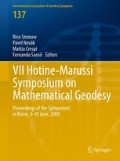Abstract
For geodetic and geophysical purposes, such as geoid determination or the study of the Earth’s structure, heterogeneous gravity datasets of various origins need to be combined over an area of interest, in order to derive a local gravity model at the highest possible resolution. The quality of the obtained gravity model strongly depends on the use of appropriate noise models for the different datasets in the combination process. In addition to random errors, those datasets are indeed often affected by systematic biases and correlated errors.
Here we show how wavelets can be used to realize such combination in a flexible and economic way, and how the use of domain decomposition approaches allows to recalibrate the noise models in different wavebands and for different areas. We represent the gravity potential as a linear combination of Poisson multipole wavelets (Holschneider et al. 2003). We compute the wavelet model of the gravity field by regularized least-squares adjustment of the datasets. To solve the normal system, we apply the Schwarz iterative algorithms, based on a domain decomposition of the models space. Hierarchical scale subdomains are defined as subsets of wavelets at different scales, and for each scale, block subdomains are defined based on spatial splittings of the area. In the computation process, the data weights can be refined for each subdomain, allowing to take into account the effect of correlated noises in a simple way. Similarly, the weight of the regularization can be recalibrated for each subdomain, introducing non-stationarity in the a priori assumption of smoothness of the gravity field.
We show and discuss examples of application of this method for regional gravity field modelling over a test area in Japan.
Access this chapter
Tax calculation will be finalised at checkout
Purchases are for personal use only
References
Andersen OB, Knudsen P (1998) Global marine gravity field from the ERS-1 and Geosat geodetic mission altimetry. J Geophys Res 103:8129–8137
Biancale R, Lemoine J-M, Balmino G, Loyer S, Bruisma S, Perosanz F, Marty J-C, Gegout P (2005) Three years of decadal geoid variations from GRACE and LAGEOS data, CD-Rom, CNES/GRGS product
Chambodut A, Panet I, Mandea M, Diament M, Jamet O, Holschneider M (2005) Wavelet frames: an alternative to the spherical harmonics representation of potential fields. Geophys J Int 168:875–899
Chan T, Mathew T (1994) Domain decomposition algorithms. Acta Numerica 61–143
Ditmar P, Klees R, Liu X (2007) Frequency-dependent data weighting in global gravity field modeling from satellite data contaminated by non-stationary noise. J Geodes 81:81–96
Drinkwater M, Haagmans R, Muzzi D, Popescu A, Floberghagen R, Kern M, Fehringer M (2007) The GOCE gravity mission: ESA’s first core explorer. Proceedings of the 3rd GOCE User Workshop, 6–8 November 2006, Frascati, Italy, pp 1–7, ESA SP-627
Engl HW (1987) On the choice of the regularization parameter for iterated Tikhonov regularization of ill-posed problems. J Approx Theory 49:55–63
Featherstone W, Evans JD, Olliver JG (1998) A Meissl-modified Vaníček and Kleusberg kernel to reduce the truncation error in gravimetric geoid computations. J Geodes 72(3):154–160
Freeden W, Gervens T, Schreiner M (1998) Constructive approximation on the sphere (with applications to geomathematics), Oxford, Clarendon, Oxford
Holschneider M, Chambodut A, Mandea M (2003) From global to regional analysis of the magnetic field on the sphere using wavelet frames. Phys Earth Planet Inter 135:107–124
Kern M, Schwarz P, Sneeuw N (2003) A study on the combination of satellite, airborne, and terrestrial gravity data. J Geodes 77(3–4):217–225
Koch K-R (1986) Maximum likelihood estimate of variance components. Bull Geodes 60:329–338
Kuroishi Y (2009) Improved geoid model determination for Japan from GRACE and a regional gravity field model. Earth Planets Space 61(7):807–813
Kuroishi Y, Keller W (2005) Wavelet improvement of gravity field-geoid modeling for Japan. J Geophys Res 110:B03402. doi:10.1029/2004JB003371
Kusche J (2001) Implementation of multigrid solvers for satellite gravity anomaly recovery. J Geodes 74:773–782
Kusche J (2003) A Monte-Carlo technique for weight estimation in satellite geodesy. J Geodes 76(11–12):641–652
Panet I, Jamet O, Diament M, Chambodut A (2004) Modelling the Earth’s gravity field using wavelet frames. In: Proceedings of the Geoid, Gravity and Space Missions 2004 IAG Symposium, Porto
Panet I, Chambodut A, Diament M, Holschneider M, Jamet O (2006) New insights on intraplate volcanism in French Polynesia from wavelet analysis of GRACE, CHAMP and sea-surface data. J Geophys Res 111:B09403. doi:10.1029/2005JB004141
Sansò F, Tscherning CC (2003) Fast spherical collocation: theory and examples. J Geodes, 77, 101-112
Schmidt M, Kusche J, Shum CK, Han S-C, Fabert O, van Loon J (2005) Multiresolution representation of regional gravity data. In: Jekeli, Bastos, Fernandes (eds) Gravity, geoid and space missions. IAG Symposia 129, Springer,New York
Tapley B, Bettadpur S, Watkins M, Reigber C (2004) The gravity recovery and climate experiment: Mission overview and early results. Geophys Res Lett 31:L09607. doi:10.1029/2004GL019920
Tenzer R, Klees R (2008) The choice of the spherical radial basis functions in local gravity 709 field modeling. Studia Geophysica Geodetica 52(3):287–304
Wesseling P (ed) (1991) An introduction to multigrid methods. Wiley, New York, 294 p
Xu J (1992) Iterative methods by space decomposition and subspace correction. SIAM Rev 34(4):581–613
Author information
Authors and Affiliations
Corresponding author
Editor information
Editors and Affiliations
Rights and permissions
Copyright information
© 2012 Springer-Verlag Berlin Heidelberg
About this paper
Cite this paper
Panet, I., Kuroishi, Y., Holschneider, M. (2012). Flexible Dataset Combination and Modelling by Domain Decomposition Approaches. In: Sneeuw, N., Novák, P., Crespi, M., Sansò, F. (eds) VII Hotine-Marussi Symposium on Mathematical Geodesy. International Association of Geodesy Symposia, vol 137. Springer, Berlin, Heidelberg. https://doi.org/10.1007/978-3-642-22078-4_10
Download citation
DOI: https://doi.org/10.1007/978-3-642-22078-4_10
Published:
Publisher Name: Springer, Berlin, Heidelberg
Print ISBN: 978-3-642-22077-7
Online ISBN: 978-3-642-22078-4
eBook Packages: Earth and Environmental ScienceEarth and Environmental Science (R0)

